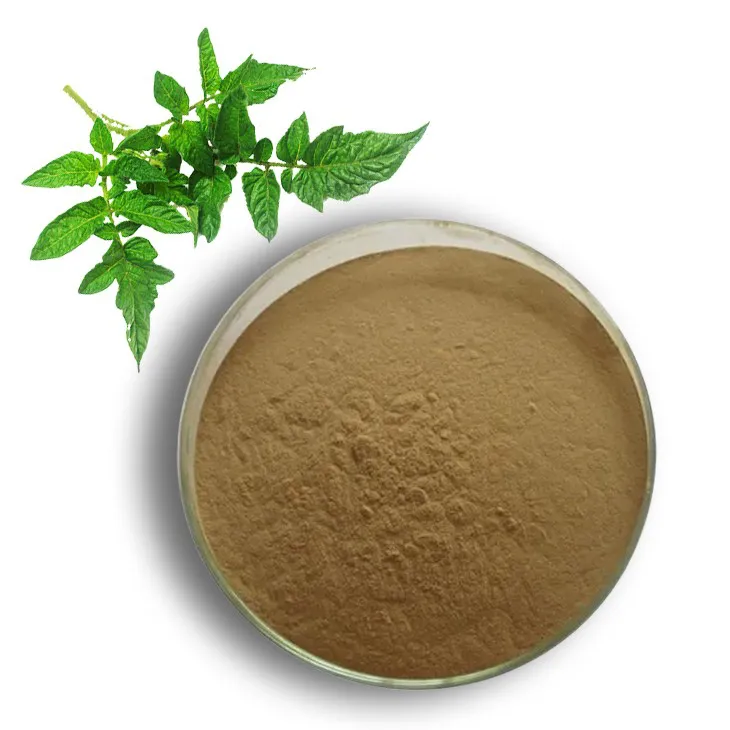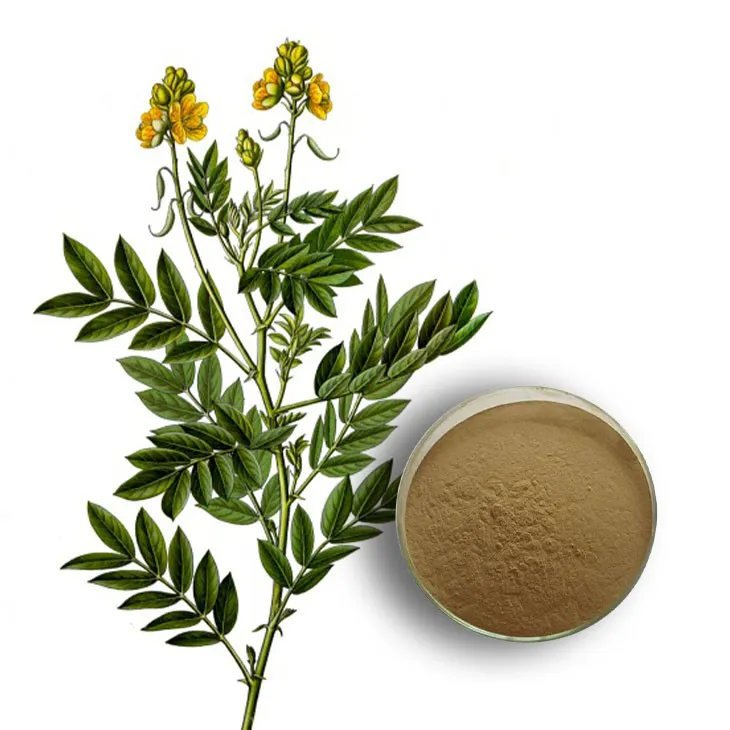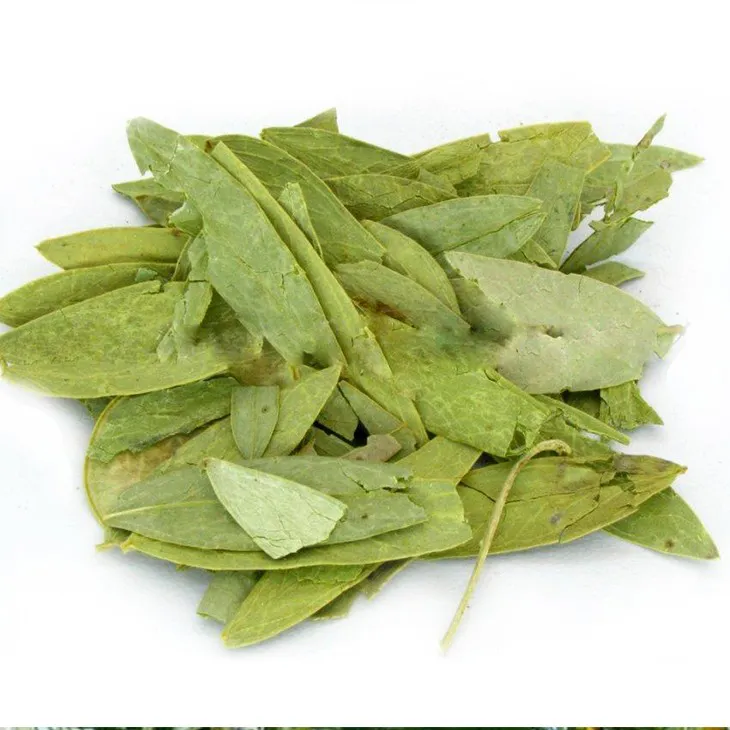- 0086-571-85302990
- sales@greenskybio.com
The process of extracting sennosides from senna leaf extract.
2024-11-29

1. Introduction
Senna Leaf Extract is a valuable natural product that contains sennosides among other components. Sennosides have important applications in the pharmaceutical and dietary supplement industries. The extraction of sennosides from Senna Leaf Extract is a crucial process that requires careful consideration of various factors. This article will detail the complex yet systematic process involved in extracting sennosides from Senna Leaf Extract.

2. Preparation of Senna Leaf Extract
2.1 Drying of Senna Leaves
The first step in preparing senna leaf extract for sennoside extraction is drying the senna leaves. Drying helps to remove moisture, which can interfere with the extraction process. There are different methods of drying, such as air - drying and oven - drying. Air - drying is a more natural method that involves spreading the senna leaves in a well - ventilated area. However, it may take a longer time compared to oven - drying. Oven - drying allows for more controlled drying conditions, with the ability to set specific temperatures. For example, a temperature of around 40 - 50°C can be used to dry the senna leaves without causing significant damage to the active components.
2.2 Grinding of Senna Leaves
After drying, the senna leaves need to be ground into a fine powder. Grinding increases the surface area of the leaves, which in turn improves the extraction efficiency. A mortar and pestle can be used for small - scale grinding, but for larger quantities, mechanical grinders are more suitable. The powder should be as fine as possible to ensure maximum contact between the leaf material and the extraction solvent. However, it is important to note that excessive grinding may cause some degradation of the active components, so the grinding process should be carefully controlled.
3. Solvent Extraction
3.1 Selection of Solvent
Solvent extraction is a key step in obtaining sennosides from senna leaf extract. The choice of solvent is crucial. Ethanol and methanol are two commonly used solvents for this purpose. Ethanol is preferred in some cases due to its relatively lower toxicity compared to methanol. However, methanol may offer better solubility for some of the components in the senna leaf extract. The solvent should be of high purity to avoid introducing impurities into the extract.
3.2 Extraction Procedure
Once the solvent is selected, the ground senna leaf powder is mixed with the solvent. A suitable ratio of powder to solvent needs to be determined. For example, a ratio of 1:10 (w/v) of senna leaf powder to solvent may be used. The mixture is then stirred or shaken for a certain period of time, usually several hours. This allows the sennosides to dissolve in the solvent. Longer extraction times may lead to higher yields, but it also increases the risk of extracting unwanted components. After extraction, the resulting solution contains the dissolved sennosides along with other soluble components from the senna leaf extract.
4. Filtration
After the solvent extraction step, filtration is carried out to remove insoluble impurities. There are different types of filtration methods that can be used.
- Gravity Filtration: This is a simple method where the extraction solution is poured through a filter paper in a funnel. The filter paper traps the insoluble particles, and the filtrate, which contains the dissolved sennosides, passes through. However, this method may be relatively slow and may not be very effective for removing very fine particles.
- Vacuum Filtration: In this method, a vacuum is applied to speed up the filtration process. A Büchner funnel with a filter paper is commonly used. The vacuum sucks the filtrate through the filter paper more quickly, leaving the insoluble impurities behind. This method is more efficient than gravity filtration, especially when dealing with larger volumes of the extraction solution.
5. Purification
5.1 Chromatography
Chromatography is an important purification step for isolating and purifying sennosides.- High - performance liquid chromatography (HPLC): HPLC is a widely used chromatographic technique for sennoside purification. It works based on the different chemical properties of sennosides and other compounds in the extract. In HPLC, the sample is pumped through a column filled with a stationary phase. The mobile phase, which is a liquid, carries the sample through the column. Sennosides and other components interact differently with the stationary and mobile phases, resulting in their separation. HPLC can achieve high - level purification and can accurately determine the concentration of sennosides in the purified sample.
- Column Chromatography: Column chromatography is another option. It is a more traditional chromatographic method. A column is packed with a suitable adsorbent material, such as silica gel or alumina. The extraction solution is loaded onto the top of the column, and then a solvent (eluent) is passed through the column. Different components in the extract will move through the column at different rates depending on their affinity for the adsorbent and the eluent. Sennosides can be collected as they elute from the column at a specific time or volume.
5.2 Other Purification Methods
In addition to chromatography, other purification methods may also be considered.- Recrystallization: Recrystallization can be used to purify sennosides. The crude extract containing sennosides is dissolved in a suitable solvent at a high temperature. As the solution cools, the sennosides will crystallize out, leaving some of the impurities in the solution. However, this method may not be as effective as chromatography for achieving high - purity sennosides.
- Preparative Thin - Layer Chromatography (PTLC): PTLC is a form of thin - layer chromatography that can be used for preparative purposes. A thin layer of adsorbent material is coated on a plate. The sample is spotted on the plate, and then the plate is developed with a solvent. Sennosides can be scraped off the plate after separation and then further processed to obtain pure sennosides.
6. Analysis of Purified Sennosides
Once the sennosides are purified, they need to be analyzed to determine their purity and quantity.
- Spectroscopic Analysis: Spectroscopic techniques such as ultraviolet - visible (UV - Vis) spectroscopy can be used. Sennosides have characteristic absorption spectra in the UV - Vis region. By comparing the absorption spectra of the purified sample with that of a standard sennoside sample, the purity of the sennosides can be estimated. Infrared (IR) spectroscopy can also provide information about the functional groups present in the sennosides, which can be used to confirm their identity.
- Mass Spectrometry: Mass spectrometry (MS) is a powerful technique for analyzing sennosides. It can determine the molecular weight of sennosides and their fragmentation patterns. This information is useful for identifying the sennosides and detecting any impurities that may have a different molecular weight. High - resolution mass spectrometry can provide more accurate molecular weight determination and help in the identification of minor components in the sennoside sample.
7. Applications of Sennosides
Purified sennosides have a wide range of applications.
- Pharmaceutical Applications: Sennosides are widely used as laxatives in the pharmaceutical industry. They stimulate the bowel movement by increasing the peristaltic activity in the colon. They are often used to treat constipation, either alone or in combination with other drugs. In addition, research is being carried out to explore their potential in other areas such as anti - inflammatory and anti - cancer properties.
- Dietary Supplement Applications: Sennosides are also used in dietary supplements. They are included in some products marketed for digestive health. However, it is important to note that the use of sennosides in dietary supplements should be carefully regulated to ensure safety, as excessive intake may cause adverse effects such as abdominal cramps and diarrhea.
8. Conclusion
The extraction of sennosides from senna leaf extract is a multi - step process that involves preparation of the extract, solvent extraction, filtration, purification, and analysis. Each step is crucial for obtaining high - quality sennosides that can be used in various applications. With the increasing demand for natural products in the pharmaceutical and dietary supplement industries, the efficient extraction and purification of sennosides from senna leaf extract will continue to be an important area of research and development.
FAQ:
What are the main steps in extracting sennosides from senna leaf extract?
The main steps include carefully preparing the senna leaf extract (such as drying and grinding the leaves), using solvent extraction (with solvents like ethanol or methanol), filtration to remove insoluble impurities, and purification using chromatography techniques like HPLC.
Why are ethanol or methanol often chosen as solvents in sennoside extraction?
Ethanol and methanol are good solvents for sennoside extraction because they can effectively dissolve sennosides from the senna leaf extract. They have suitable chemical properties that allow them to interact with sennosides and separate them from other components in the extract.
How does chromatography help in purifying sennosides?
Chromatography, like HPLC, helps in purifying sennosides by separating them from other similar compounds based on their different chemical properties. Different compounds move at different rates through the chromatographic column, allowing sennosides to be isolated.
What is the significance of drying and grinding senna leaves before extraction?
Drying and grinding senna leaves before extraction is significant as it helps to obtain a fine powder. This fine powder has a larger surface area, which in turn improves the extraction efficiency, allowing more sennosides to be dissolved out during the solvent extraction process.
What are the applications of the purified sennosides?
The purified sennosides can be used in various applications such as in the pharmaceutical industry for medicinal purposes or in the dietary supplement industry.
Related literature
- Isolation and Characterization of Sennosides from Senna Leaves"
- "Optimization of the Extraction Process of Sennosides from Senna"
- "The Role of Sennosides in the Pharmaceutical Field: A Review"
- ▶ Hesperidin
- ▶ Citrus Bioflavonoids
- ▶ Plant Extract
- ▶ lycopene
- ▶ Diosmin
- ▶ Grape seed extract
- ▶ Sea buckthorn Juice Powder
- ▶ Fruit Juice Powder
- ▶ Hops Extract
- ▶ Artichoke Extract
- ▶ Mushroom extract
- ▶ Astaxanthin
- ▶ Green Tea Extract
- ▶ Curcumin
- ▶ Horse Chestnut Extract
- ▶ Other Product
- ▶ Boswellia Serrata Extract
- ▶ Resveratrol
- ▶ Marigold Extract
- ▶ Grape Leaf Extract
- ▶ New Product
- ▶ Aminolevulinic acid
- ▶ Cranberry Extract
- ▶ Red Yeast Rice
- ▶ Red Wine Extract
-
Ginger Extract
2024-11-29
-
Centella Asiatica Extract
2024-11-29
-
Pine bark Extract Powder
2024-11-29
-
Coconut Water Powder
2024-11-29
-
Maca Extract
2024-11-29
-
Sea buckthorn oil
2024-11-29
-
Nettle Root Extract
2024-11-29
-
Curcumin Extract
2024-11-29
-
Saw Palmetto Extract
2024-11-29
-
Saponin Extract
2024-11-29





















